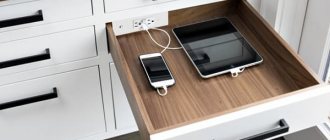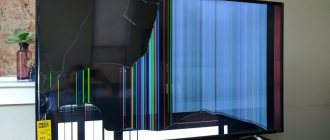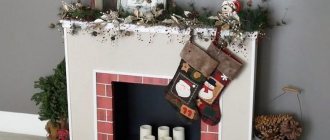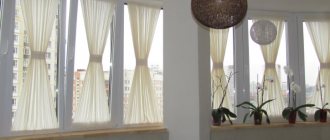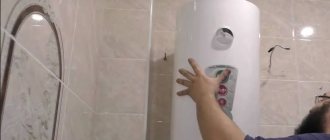Photo: planete-deco.fr Installing a television panel on the wall is one of the most rational solutions that allows you to achieve maximum freedom of space. At the same time, the question arises - how to hide wires that significantly spoil the external aesthetics of the interior? To help you in this matter, we have collected 12 great ideas, among which you will definitely find what you need!
Hiding wires in the wall
At the renovation stage, you can hide the wires from the TV in the wall. To do this, you need to accurately determine the permanent place of “residence” for the television panel.
Next, starting from the intended location of the wire, make a channel in the wall towards the electrical point and lay the cable. Use special construction staples to securely fix it, and then carefully cover it with plaster. Now you can start finishing work.
This method has one significant drawback - the television panel loses its mobility. If you need to move it to another location or send it in for repairs, removing the wire will be very problematic.
Where can you hide wires?
A cable sticking out in plain sight can ruin the entire design idea of a room. Before hanging the plasma on the wall, you need to consider options for masking the cable system so that it is not visible. Let us describe some ways to solve this pressing problem.
On the wall
The safest, but time-consuming, physical effort and financial way, is to run the wires directly into the wall.
Wiring hidden in the wall does not at all interfere with the aesthetic appearance of the room.
If there is a concrete partition in the wall where the socket is installed, then there is no way to do without gating. This is a very loud, dusty and dirty activity, which is only possible with a major renovation, otherwise the whole room will be covered in fine dust, which will be very difficult to wash off the furniture.
If the rough finishing stage is in full swing, then the following manipulations must be carried out:
First you need to draw a diagram of the location of the sockets. Mark the entrances and exits of the route. The strobe must be positioned vertically or horizontally to the nearest outlet. There may already be electrical cables in the wall cavity, so you need to use a tool to identify hidden electrical wiring.
For such work, you must have at least some knowledge of electrical wiring.
It is much easier if the TV needs to be hung on a plasterboard wall. In this case, you need to mark the distance from the TV mount to the outlet and stretch the cable into the open cavity of the wall behind this drywall.
Under the floor
It is quite possible to run the wire directly under the floor covering; special plastic skirting boards with a niche for the cable are sold for this purpose. With this method, you first need to remove the outer panel and lay the wire from the TV there. This method is characterized by fast, unpretentious and clean installation.
To hide the wiring from the TV under a plastic plinth in the floor, you need to arm yourself with a hammer drill and make a long groove in the floor surface. Place the wire in a corrugation and fill the groove with cement-sand mortar.
If the house or apartment has wooden floors (laminate, parquet), then you need to remove the necessary boards and place the wires in an open hollow container in a metal case.
When laying cables in the floor, you must use a special corrugation.
In the cable channel
This is the simplest and most affordable way to mask wires. The store offers: metal and plastic types of products. This way you can easily and safely hide the wires. This method complies with all fire safety standards.
Before purchasing a cable channel, you need to calculate the number of all the wires that will be located in it, and also measure the distance to the nearest outlet. Typically, these products are sold in 2-meter-long sections, which are then connected with special corners. The shade must be selected in accordance with the color of the walls.
Under the furniture
Under the hanging plasma you can place a wall panel with a compartment for laying wires and a closing door. A banquette in the style of a general interior would also look good under the plasma. However, most often a cabinet or table is placed under the equipment, as the most common and convenient furniture that hides the wires. You just need to install this furniture in the place where the TV is located and all the cables will be hidden behind the shelves and walls of the cabinet.
Important! If you need to lay electrical wires horizontally, along the wall or low in relation to the floor, it is best to use a plinth with a built-in cavity for the cable.
The plasma can be placed in a hidden niche made of a special material - plasterboard, which is an additional part of the cabinet. It will be convenient to place the wiring behind it, which will not be noticeable.
Cable as decor
As decoration, you can use designer boxes that turn the wires into a thematic detail of the room’s interior. The following types of decorative boxes are distinguished:
In the Art Nouveau or high-tech style, boxes decorated to look like brick are ideal. For a loft, you should choose products in the form of pipes in black or another dark color. In the popular eco-style, wooden boxes for wires look chic.
In addition, this decorative element can easily be painted in any shade or additionally decorated with wooden boards to match the color and texture of the walls in the room.
Long wires can be assembled into original compositions that will fit well into the interior design.
Before creating a composition of cables, you need to draw up a diagram of their location and transfer it to the wall, and only then change the length of the necessary wires with a thread.
Cables wrapped in a colored casing with different decorative elements and overlays that match the wallpaper in color and design look attractive.
If the color scheme does not match the style of the room, then you can collect all the wires into one single-color extension cord. There are now a lot of choices for every taste.
The wire from the TV looks mysterious and fabulous if you decorate it with LED strip or garland. In ethnic style, you can wrap massive and large beads on the cable.
In the children's room, electrical wires are masked with various stickers and figures of cartoon characters. In the girls' bedroom, you can wrap lace, artificial flowers and colored feathers.
Masking with a cable channel
Use a camouflage box. With its help you will hide television wires without disturbing the surface of the wall. This structure is fastened with hidden screws and liquid nails.
Today you can purchase a cable channel model that best suits the style of the room. The simplest type is an ordinary plastic box, which after installation can be covered with the same finishing material as the entire wall.
There are models lined with decorative bricks or in the form of pipes, which are ideal for interiors in loft and hi-tech styles. For classic or eco-trends, you can choose wooden or MDF models.
Using a decorative panel
A decorative panel can be added to the interior at any time. Usually this is a structure made of plasterboard or wood, hollow inside. All the necessary wires will fit perfectly there. If it is a solid slab of chipboard or MDF, you can make special recesses inside for the wires.
A decorative panel can be part of furniture. Factory models are unlikely to have cells for wires. Alternatively, you can tape them to the back. Typically, such furniture does not fit flush against the wall. Or, when making custom-made furniture, ask to take this small nuance into account.
The TV itself may be located in a niche. If possible, you can make the niche a little deeper than needed for the TV, and place the wires inside too. Or, if the wall is made of plasterboard, just run the wires down inside it.
You can also make a decorative panel yourself. For example, using boards or old pallets. Firstly, it will become an original accent in the interior. Secondly, it will solve the issue with the wires. This technique will automatically add brutality to the interior.
A fabric panel can also serve as a decorative panel. It's very easy to make. All you need is durable fabric, wooden strips and small nails. An example in the photo below. Don't worry, the TV itself will be attached to the wall and not to the fabric. Using a similar principle, you can make a panel from plasterboard or chipboard.
Hiding behind drywall
Drywall is widely used in the design of modern interiors, as it allows you to mask surface imperfections and create original decorative designs. Why not take advantage of this?
Come up with a wall structure, for example, in the form of a plasterboard box with niches, shelves and, of course, space for a television panel. After installation, all wires will be securely hidden, and the interior of the room will become more stylish and functional.
You can build a false fireplace from drywall and install a TV above it. This way you will get a great seating area, and the wires will be securely hidden.
Cable mounting options
Fastenings for cables and wires can be made in several options:
- Cable tie with a hole for a dowel.
- Mounting area in the form of a square.
- Clips for corrugated pipes.
- Metal bracket.
- Platform with self-adhesive backing.
Cable tie with dowel hole
A cable tie with a dowel hole is an improved design of a standard product. It is used for fastening a single cable or a bundle of conductors. This fastening for various wires allows you to do without additional intermediate parts. The loop is tightened around the cable. The self-tapping screw is driven through the hole in the clamp into a standard dowel.
Screed with a hole for a dowel
The fasteners are made of nylon. The locking opening allows the toothed belt to move in one direction only. The screed is dismantled using sharp tape.
Mounting area in the form of a square
The support platforms are made of nylon. Products come in three types:
- with a hole for a dowel or screw;
- platform with dowel;
- Adhesive fastening.
All types of products have grooves for threading tie tape. The polymer platforms are square in shape. Their sizes are 19x19, 28x28, 40x40 mm.
Clips for corrugated pipe
To isolate the surface of the cables from external negative factors, they are pulled into corrugated pipes. To attach the corrugations to the walls and ceiling, use clips for wires.
Clip design
Fasteners are necessary for fixing corrugated pipes on vertical fences indoors. Clips for fastening cables have latching brackets. They unbend under force, letting the pipe inside, and immediately snap into place. The base of the products has holes for dowels or screws.
Clips for fastening cables in corrugated pipes have the following working diameters: 16, 20, 25, 32, 40 and 50 mm.
Metal bracket
Metal staples are used as reliable fastening of wires on walls. The fasteners have technological holes through which the brackets are attached using screws, self-tapping screws or fired with a dowel gun.
Metal products can have one or two legs. Two-component holders consist of two brackets connected through ebbs with screws. The lower stock has a hole for a dowel screw. It has an international marking indicating the diameter of the coverage.
For example, GN 20 means a single-jaw staple with a reach diameter of 19-20 mm. CZ 16 – two-legged holder with a diameter of 16-17 mm. A two-component bracket with an internal diameter of 31-32 mm is designated as C 32.
Platform with self-adhesive backing
The products are plastic squares with protrusions in the form of grooves for ties. The back side is covered with double-sided tape.
Self-adhesive pads are used when it is necessary to attach wires to the wall without violating the integrity of the fence surface. Fasteners are quick installation parts.
Self-adhesive pads
How to hide wires in furniture
The TV can be installed in a wall set, which will hide all communications in its depths. But if you don’t like bulky structures, use modular elements, such as a wall cabinet.
Many modern models of such furniture already have special holes in their design into which wires are laid.
Stretch ceilings in the interior of an apartment (200 photos)
How to hide wiring in a wall made of concrete and plasterboard?
Laying cables in the wall is one of the most difficult options and is only used if you are going to do a renovation. It is necessary to cut out the grooves and lay the wires beautifully, cover them with alabaster or seal them with putty. But if the room is already being renovated, and you are not going to tear off expensive wallpaper or knock off the paint, then this option is not suitable. The chipping is carried out using a grinder or a special hammer drill.
For this option to work, you must initially draw a diagram on a piece of paper, in what order, where and how the wires will be located so that they reach the sockets. If you are not going to tear off the wallpaper, you will have to deal with the wires using another method.
Grilling for wires
One of the simplest options is a backfill between the drywall and the wall. This method is suitable if the walls were leveled using drywall.
Instructions:
- Working with this material is very simple; you need to use a special knife that is used to cut drywall and make grooves for the wires.
- Next, the wiring is laid and covered with putty or alabaster. This method is also used if you are going to make repairs. If not, you can do it another way.
- To do this, you will need the following available materials: nut, thread, hook, wire. You need to hang the nut on a thread, cut a very small hole in the wall, lower the thread with the nut down from above, make a hole at the bottom, and remove the nut through the bottom slot.
- Next, you need to connect the wire, that is, tie it to a thread and pull it out through the top hole. This way the wire will be in the wall. You will hide the wires without cutting or making a tunnel.
- A fairly simple and inexpensive method that does not require additional costs. If the walls are not plasterboard, but concrete, then you will have to cope on your own.
Wires in drywall
Wire panel
If you are a creative person, come up with some kind of wall drawing, the contours of which you will draw with wire. You can find quite a lot of such ideas on the Internet!
Draw a sketch on the wall with a pencil and start laying. Don’t forget that the pattern or geometric figure should fit harmoniously into the interior.
An important point is the method of fixation. Nails are not suitable for this work - they can damage the cable and spoil the design with their unaesthetic appearance. Therefore, use double-sided tape or glue.
Hiding wiring and low-current wires
I would like to start with the wiring, that is, with the cables running from the distribution infrastructure in the entrance to the power points - sockets. In addition, this section is also relevant for low-current wires for telephone and Internet. As a rule, these wires are hidden in the floor, walls or ceiling, or are run through special cable runs. But first things first.
Walls
Traditionally, two types are used:
- Grilling. Making recesses in an existing wall. As a rule, this is a shallow groove, which we create using a hammer drill, grinder or a special tool - a wall chaser. After this, the wires are simply laid into the grooves and sealed with putty;
- Gasket under gypsum board. Often, when decorating a room, plasterboard sheets are used, which not only cover existing walls, but also create new partitions. In this case, installation is greatly simplified, since there is a distance under the plasterboard sheets due to the presence of the frame.
All these methods have common rules:
- Wires should be laid no closer than 15 centimeters from the ceiling;
- Diagonal laying is not allowed - you need to work only in horizontal or vertical directions;
- You must know exactly where the wires are laid so as not to touch them in the future. Map the wiring in the walls;
- To make it easier to control the supply of electricity, distribution boxes are installed along the route of the wires.
Ceiling
In the case of ceilings, gating occurs in the same way as walls. Thus, we can bring the wire to the place where the chandelier is fixed. After this, all that remains is to level the area and carry out the general finishing of the ceiling. However, it is much more convenient to use suspended ceilings, plasterboard sheets and other finishing methods, including stretch options. In this case, there are niches into which wires can already be placed. In addition, we can provide electricity not only to the chandelier, but also to create many different lighting concepts, supplying power to all light sources. As for communication wiring, low-voltage wiring is usually not laid anywhere other than walls.
Floor
The most rare method. After all, dismantling the floor to replace the wire is much more difficult than in the case of a wall. In addition, heating systems are often installed in the floor, and there is simply no room for other communications. Finally, floors can flood or simply be exposed to moisture, which is not a good thing in the case of electricity.
But if you still decide to do this, then they usually use grooves in a ready-made cement floor, as is the case with walls. Also, wires in corrugated channels can be laid in a screed, pouring cement on top.
Masking with vinyl stickers
Interior vinyl stickers are an excellent decorative material. Its main advantage is that it allows you to quickly transform the interior and emphasize style. At the same time, such decor can be removed or replaced with a new one at any time without any problems.
Use vinyl stickers to create decorations where the TV cable is located. It could be a branchy tree, with the crown of which the cable will blend into the color palette.
Running cables along the floor or ceiling
To prevent the wiring from getting in the way, it is also closed to the floor. To do this, install plinths with a removable cover and a niche for cords. The method is simple, convenient, and requires virtually no repair work. And besides the television cable, other communications can be installed in the niche.
If the floor is concrete, there is a way out. Using a puncher, holes are drilled out in it, a recess is made, and then corrugation with wiring is placed there. The top is sealed with cement mortar.
An option for a wooden floor is to remove the board and lay a metal cable channel with communications underneath it.
Placing TV wires under the ceiling is a safe way (children and animals cannot reach them). At the same time, it is not necessary to spoil the walls by gating. Options:
- install fireproof corrugations and fix them with staples to the ceiling;
- use skirting boards with a niche for wiring;
- hide the cables under the suspended ceiling.
You can hide the wire this way.
Safety precautions require that each cable be insulated. If there are several cords in one channel, use fireproof corrugations.
Wires behind a wooden panel
Installing a wooden panel with a TV will not only adequately highlight the design of the room, but will also become an excellent camouflage element that will allow you to hide the wires.
Wooden panels can have a different color palette and shape, adding sophistication and presentability to the interior. In addition, the material will serve as a good sound insulator, so you won’t have to worry about the indignation of picky neighbors who are dissatisfied with the increased volume.
60+ beautiful narrow bedroom design ideas (photos)
Branches of dry and artificial plants
Wires from the TV can also be hidden using branches of artificial plants. Place a vase with dry twigs near or under the TV panel and all attention will shift to an attractive-looking composition.
You can use special wire covers in the form of branches, which are quite similar in design to cable channels, but at an aesthetic level they are much superior. Such functional decor will look great in a children's room.
To the floor
The second way is to hide the cords under the floor. Today in construction stores you can easily buy special skirting boards equipped with a niche for masking the cable. You just need to remove the outer panel, and then remove the wires into this space. Then install the panel back.
The main advantage of this option is efficiency, cleanliness, and simplicity. Work takes up minimal free time. To cover the cords under the baseboard, you don't have to hammer anything. No dirt, etc. Antenna and Internet cables can be placed under the baseboard. With their help, other communications are also masked.
The antenna cable of the TV can also be hidden on the floor, or rather under it. How can I do that? Take a hammer drill, and then make holes in the floor, which will actually be intended for the wires. Use corrugation to create a protective layer, and then you can lay the cords.
When installation is complete, level the floor using a mixture of sand and cement. If the apartment has a wooden floor, then you will need to dismantle the boards and place the wires in a metal tube.
Wires in “ethnic” style
If the interior of your TV room is decorated in an ethical style or you simply like to surprise with the “quirks” of the interior, take note of the option of masking wires with beads. Of course, you will need fairly large parts that will fit freely on the cable.
Pay attention to the selection of colors - you can choose plain details to match the color of the wall or contrasting ones that attract attention. White and red beads are suitable for wallpaper in warm colors, and blue, green and black - in cold colors.
Important nuances when working with TV wires
Television is supplied to the apartment via cables. Various cords also come from the equipment itself, and along them there is electricity, which requires compliance with safety precautions:
- Before starting electrical wiring, it is necessary to de-energize the room. In general, this is done by people with permission to carry out such work - electricians. Without experience and knowledge, it is better not to do anything yourself;
- before working with cords, they are disconnected from the network;
- If you want to decorate a wire, you need to make sure that its sheath is intact and without damage.
To make the equipment last longer, the cords are placed loosely, but not tightly.
It would seem like a minor issue - cables on the wall, but how do they affect the integrity of the interior. The article describes several ways to mask communications, both simple cords, for example, HDMI, and antennas. If necessary, use your imagination and create original decor from familiar things.
Hiding wires with threads and ropes
Another simple way to hide TV wires is to wrap them with colored threads, ribbons or jute rope.
You can choose one of several design methods. For example, simply twist the wire or braid it with a pigtail. The color of the material should be in harmony with the surrounding environment.
Suspended ceilings: 100 design ideas (photos)
Features of the TV location
It is best to ask this question in advance, think through and design the installation of the device and its terminals. The standard rule is one TV outlet and three regular outlets behind the plasma monitor. They connect the TV itself, an Internet adapter, an Xbox or another game console if necessary.
All these outputs will be securely hidden behind the plasma monitor; the sockets must be installed 9-12 cm above or below the edge of the plasma.
If there is a TV stand under the plasma, on which you can place other types of equipment, then sockets behind it will also not hurt.
At a height of 40 cm from the floor covering, place a single block of 3-4 sockets, even if they are not useful now, it is better to be safe for the future. Extra sockets will eliminate problems with wires, cables and additionally included carriers.
How to properly hide the wires coming from the TV on the wall if the renovation has already come to an end? When the repair is complete, all cables can be carefully hidden in a box with a niche and carefully secured to the TV. Then it all depends on your imagination and preferences in decorating the box for the interior item. It can be disguised to match the color of the wall, wallpaper, or, conversely, highlight it with a bright shade.
When television equipment is located opposite a window, it is necessary that the light does not block the picture on the screen. In this case, thick fabric or electric curtains will help. In the second option, you need to prepare another socket in the place where the electronic curtain will hang.
Not all TV models are attached to a wall surface: a lot depends on the model, the weight of the equipment and the material of the wall surface. It is also important to consider the quality and reliability of the fastening bolts. The wall must be strong and able to support the weight of the TV. Ideally, the equipment is attached to a brick or concrete wall.
If the TV will be on a bedside table or coffee table, then the sockets directly behind it are perfect for discreetly plugging them into the network.
Use books and magazines
Even books can be good helpers in trying to hide television wires. Try to choose ones that have a neat, aesthetic appearance or with bright covers.
Books and magazines can be stacked on a table or shelf under the TV. Pick up a couple of high-end editions that will reach all the way to the television panel. Don't overdo it with the quantity - keep it small so as not to create a mess.
Phytostena
Installing a phytowall is a stylish solution for any modern interior. It is a large panel with “pockets” in which plants are placed. Installing a TV in such a frame has many advantages, one of which is the ability to hide the wires.
In addition to the fact that the design of the room will not be disturbed by the carelessness of a hanging cable, you will be able to enjoy watching your favorite TV shows surrounded by clean, humidified air, which is important for a city dweller!
